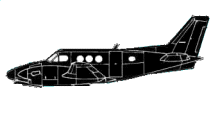
ASN Wikibase Occurrence # 183393
This information is added by users of ASN. Neither ASN nor the Flight Safety Foundation are responsible for the completeness or correctness of this information.
If you feel this information is incomplete or incorrect, you can submit corrected information.
| Date: | Tuesday 17 October 2000 |
| Time: | 15:51 |
| Type: |  Beechcraft C90 King Air |
| Owner/operator: | Sun Quest Executive Air Charte |
| Registration: | N1801B |
| MSN: | LJ-634 |
| Year of manufacture: | 1974 |
| Total airframe hrs: | 8577 hours |
| Fatalities: | Fatalities: 0 / Occupants: 3 |
| Aircraft damage: | Substantial |
| Category: | Accident |
| Location: | Van Nuys Airport, CA -
 United States of America United States of America
|
| Phase: | Approach |
| Nature: | Unknown |
| Departure airport: | Bakersfield, CA (BFL) |
| Van Nuys, CA (VNY) | |
| Investigating agency: | NTSB |
| Confidence Rating: |
The Gulfstream descended from above and behind the Beech C90 and collided with it while both aircraft were on 2.5-mile final approach to the same runway. Visual meteorological conditions prevailed. The Gulfstream was on an ILS instrument approach and the Beech was on a VFR approach. Both airplanes subsequently landed without additional damage or injury to the occupants. Upon initial contact with the air traffic control tower, the Beech C90 was instructed to make a straight-in approach to the runway and was given a transponder code. The pilot miss-set the assigned code, which, due to an air traffic control computer software anomaly, caused the Beech's identifying data block to be suppressed and not available to the radar approach controller. The approach controller attempted to provide traffic advisories to the overtaking Gulfstream pilot but could not determine the Beech's type, destination, or altitude. (Altitude data became available to the controller 1 minute 14 seconds before the collision via a conflict alert message.) The controller did not issue a traffic alert to the Gulfstream crew when the Beech's altitude became known. Additionally, for unrelated reasons, the approach controller experienced frequent failures of his communication radio transmitter and was required to repeat transmissions to the Gulfstream and other aircraft. Despite the traffic point-out, in front of them 1 mile, altitude unknown, and later at short distance at a known altitude near theirs, the Gulfstream flight crew did not visually identify and avoid the Beech nor did they request radar separation services. On initial contact with the tower, the Gulfstream crew was cleared to land on the same runway the tower had previously cleared the Beech to make a straight-in approach to. When asked by the Gulfstream if there was any traffic in their vicinity, the tower replied, "nothing reported." The tower controller realized his mistake approximately 16 seconds later, however, the collision had already occurred. The Gulfstream pilot reported there were no TCAS 2 traffic advisories within 3 miles and there were no resolution advisories. The Gulfstream first officer recalled a TCAS "traffic" advisory close by at near their altitude, but no annunciation in the minute or two before the collision. With the model TCAS aboard the Gulfstream, when the aircraft's landing gear is extended, the lower TCAS antenna goes into an omni-directional mode wherein targets detected on the lower antenna only are displayed to the flight crew on the cockpit TCAS display with a text message of range and delta altitude but no bearing information. The Beech's transponder antenna was on the lower fuselage and airframe structure shielded it from interrogation by the Gulfstream's TCAS.
Probable Cause: The failure of the pilot to correctly set a new transponder code and an anomaly in ATC software that precluded the controller from manually overriding the resulting inhibition of displayed data. Factors in the accident were impaired function of the collision avoidance system in the other airplane due to structural masking of the airplane's transponder antenna, an intermittent failure of the approach controller's communication radio transmitter which interfered with his ability to communicate traffic information to the flight crew of other airplane, the failure of both the approach controller and the tower controller to issue safety alerts when the traffic conflict became apparent, and the failure of the flight crew of the other airplane to maintain an adequate visual lookout to see and avoid the airplane.
Sources:
NTSB: https://www.ntsb.gov/_layouts/ntsb.aviation/brief.aspx?ev_id=20001212X22182&key=1
Revision history:
| Date/time | Contributor | Updates |
|---|---|---|
| 11-Jan-2016 02:39 | JINX | Added |
| 11-May-2017 16:07 | TB | Updated [Date, Time, Aircraft type, Registration, Cn, Operator, Total occupants, Location, Phase, Nature, Source, Damage, Narrative] |
| 16-Nov-2017 14:55 | TB | Updated [Operator, Total occupants, Location, Phase, Nature, Source, Narrative] |
| 12-Dec-2017 19:16 | ASN Update Bot | Updated [Time, Cn, Operator, Nature, Departure airport, Destination airport, Source, Damage, Narrative] |
Corrections or additions? ... Edit this accident description
The Aviation Safety Network is an exclusive service provided by:


 ©2024 Flight Safety Foundation
©2024 Flight Safety Foundation